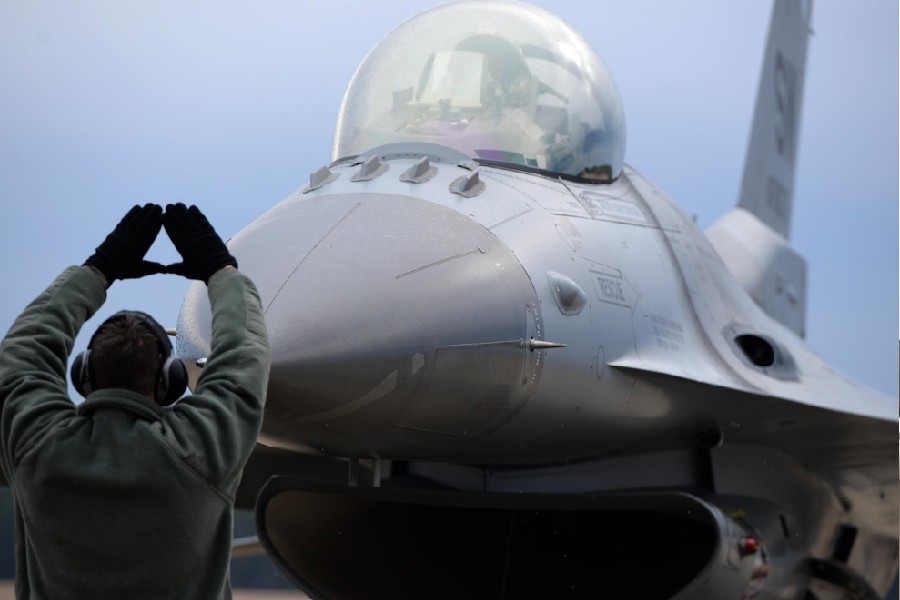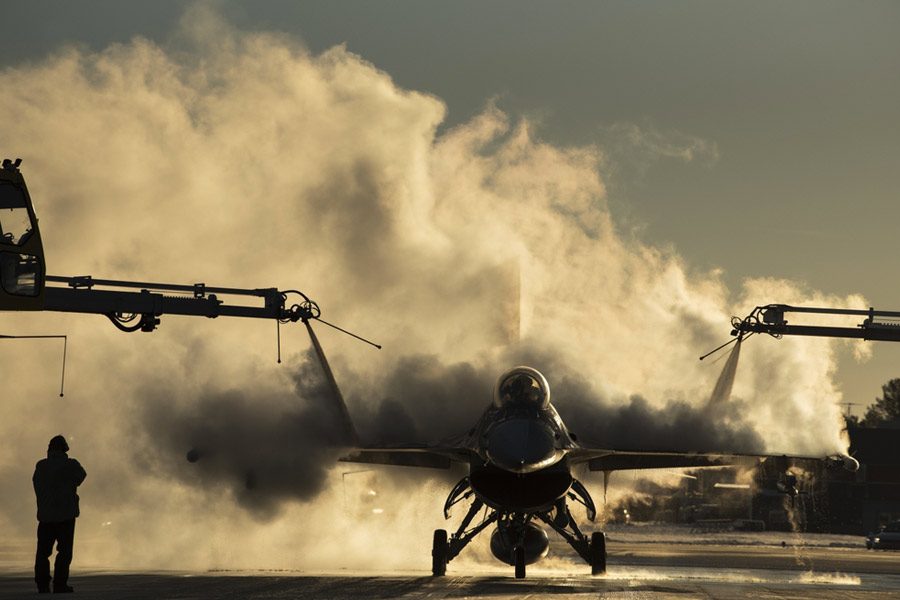The United States carried out two airstrikes against facilities used by Iran’s Revolutionary Guard and its proxies in eastern Syria early Friday in retaliation for a flurry of recent rocket and drone attacks against U.S. forces in Iraq and Syria.
The strikes by Air Force F-16 jets, against a weapons storage facility and an ammunition storage facility, were intended to send a strong signal to Iran to rein in the attacks the Biden administration has blamed on Tehran’s proxies in Syria and Iraq without escalating the conflict in the Middle East, U.S. officials said. The targets, while limited in number, represent an escalation in striking facilities used by Iran’s own forces in the region, not just the militias in Iraq and Syria that Tehran helps to arm, train and equip.
“These precision self-defense strikes are a response to a series of ongoing and mostly unsuccessful attacks against U.S. personnel in Iraq and Syria by Iranian-backed militia groups,” Defense Secretary Lloyd Austin said in a statement.
“The United States does not seek conflict and has no intention nor desire to engage in further hostilities, but these Iranian-backed attacks against U.S. forces are unacceptable and must stop,” Austin said.

Since Hamas’ surprise attack against Israel on Oct. 7, President Joe Biden and his aides have sought to contain the war between Israel and Hamas, and prevent it from spilling over into a regional conflict with Iran and its proxies in Lebanon, Syria and Iraq.
To that end, the U.S. has deployed two aircraft carriers to the eastern Mediterranean near Israel and dozens of additional warplanes to the Persian Gulf region to deter Iran and its proxies in Lebanon, Syria and Iraq from engaging in a regional war. The Pentagon has also rushed additional Patriot antimissile batteries and other air defenses to several Gulf nations to protect U.S. troops and bases in the region.
But with the near daily attacks against U.S. forces over the past 10 days — the Pentagon’s tally climbed to at least 19 by late Thursday — pressure had been mounting on the United States to respond militarily.
“These narrowly tailored strikes in self-defense were intended solely to protect and defend U.S. personnel in Iraq and Syria,” Austin said. “They are separate and distinct from the ongoing conflict between Israel and Hamas, and do not constitute a shift in our approach to the Israel-Hamas conflict.”
He added: “If attacks by Iran’s proxies against U.S. forces continue, we will not hesitate to take further necessary measures to protect our people.”
A senior Defense Department official told reporters in a briefing late Thursday that the airstrikes were not coordinated with Israel’s military.
Pentagon officials offered few details about the strikes themselves, how much damage they caused and what kind of response they might draw from Iran and its allies. They gave the following account:
Two Air Force F-16 strike aircraft based in the region dropped precision-guided bombs on a weapons storage facility and an ammunition storage facility near Abu Kamal, Syria. While rockets or drones had not been launched from the site, officials said munitions stored at the facilities were used in the recent attacks against U.S. forces.
Pentagon officials said there were people at the site during the day Thursday, but it was unclear whether any Iranian or militia personnel were injured or killed in the strikes.
As in the past, the United States opted to strike Iran-backed targets based in eastern Syria, not southern Iraq, where the groups operate with wide latitude. Administration officials have urged Iraqi officials to crack down on the groups in that area with little success. Still, conducting American airstrikes could have a destabilizing effect on the Iraqi government, which works closely with the U.S. government.
“The U.S. sent a message tonight,” Mick Mulroy, a former defense official and retired CIA officer, said in a statement late Thursday. “We will directly respond against Iran, and specifically the IRGC, if they continue to attack our military positions and personnel in Iraq and Syria.”
Biden, asked Wednesday about drone strikes against U.S. military personnel in Iraq and Syria in recent days, said that he had warned Iran “that if they continue to move against those troops, we will respond.”
The predawn U.S. retaliatory strikes Friday came just hours after the Pentagon announced that 19 U.S. military members based in Iraq and Syria have suffered traumatic brain injuries after rocket and drone attacks from Iran-backed militants last week.
The Defense Department had previously said that 21 service members had suffered minor injuries but returned to duty after the attacks on Oct. 17 and 18 at Al Asad Air Base in western Iraq and al-Tanf garrison in southern Syria.
Brig. Gen. Patrick S. Ryder, the Pentagon spokesperson, said Thursday that 15 of the 17 service members injured at al-Tanf and all four of the troops hurt at Al Asad had subsequently been diagnosed with traumatic brain injuries.
“As we’ve seen in the past, there are situations where several days after an attack, a member may self-report ringing in the ears, headaches,” said Ryder, who said there have been no other diagnoses of traumatic brain injury since then.
There are 2,500 U.S. troops in Iraq and 900 in Syria, mainly helping local allies conduct counterterrorism missions against the Islamic State group.
The airstrikes Friday follow a pattern set early in the Biden administration of retaliation against Iranian-linked groups for attacks on U.S. forces in Iraq and Syria.
Shortly after taking office, the president ordered the bombing of buildings in eastern Syria belonging to what the Pentagon said were Iran-backed militias responsible for a Feb. 15, 2021, rocket attack on an Iraq airport. That attack killed a Filipino contractor with the U.S.-led military coalition and wounded six other people, including five Americans.
In June 2021, the United States carried out airstrikes in Iraq and Syria against two Iranian-backed militias that the Pentagon said had conducted drone strikes against American personnel in Iraq.
In August 2022, the United States struck militant groups linked to the Revolutionary Guard in northeastern Syria, killing at least two fighters. Those strikes followed rocket attacks from the Iranian-backed forces, one of which wounded three U.S. service members.
In March, U.S. intelligence agencies concluded that a self-destructing drone of “Iranian origin” killed a U.S. contractor and injured another contractor and five U.S. service members in an attack on a maintenance facility on a coalition base in northeast Syria.
Biden retaliated by ordering the Pentagon to carry out airstrikes against facilities in eastern Syria used by groups affiliated with the Revolutionary Guard, but not the Iranian forces themselves.
Asked by reporters Thursday when the administration would retaliate for the latest spate of attacks against U.S. troops, Ryder said the United States always reserves the right to self-defense. “If and when we decide to respond,” Ryder said, “we would do so at a time and place of our choosing.”
That time came early Friday morning in eastern Syria.
The New York Times News Service












